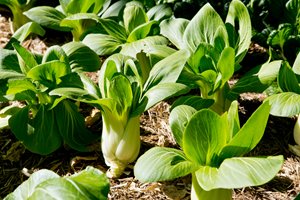If you’re looking for a low-maintenance, leafy crop to plant in your garden or polytunnel, pak choi could be the perfect choice. These versatile leaves are best enjoyed in salads and stir-fries, but they’re also great for other Asian-inspired dishes including noodles and ramen. In our handy guide below, we’ve covered everything you need to know about growing pak choi plants at home.

Growing pak choi from seed
If you’ve been wondering when to sow pak choi, you’ll find it’s hardy and can be grown throughout the year, so there’s nothing too strict to follow. However, you’ll need to remember that it goes to seed very quickly on long, warm days, so will need regular attention in the height of summer.
When planting pak choi, it’s best to sow into moist soil in small pots or a cellular tray. It’s also possible to sow directly into the ground, but your seedlings might risk being eaten by slugs if they’re kept outside.
Transplanting pak choi plants
When the seedlings reach around two inches tall, plant them firmly into soil. Along with needing to be kept relatively cool, pak choi grows well in moisture-retentive, nitrogen-rich soil. Water your pak choi plants generously and regularly, and cover the seedlings with a barrier, like horticultural fleece, to protect against flea beetles and other airborne pests.
Protecting pak choi seedlings
If you’re worried about weeds disturbing your pak choi plants but you’re hesitant to use harsh chemicals in your growing environment, don’t fret. There are plenty of
non-chemical weed control methods available to help you keep your garden – and your new pak choi seedlings – as organic as possible. For added protection, you could use a covered space like a polytunnel to nurture your pak choi plants.
Growing pak choi in a polytunnel
If you choose to grow pak choi plants with your other leafy vegetables in a
polytunnel, you’ll be helping to protect it from pests and other environmental hazards. Furthermore, these adaptable, protective spaces are available with purpose-built
polytunnel accessories, including netting and ground covers to keep your plants as safe as possible.
What to do with a flowering pak choi plant
Sometimes pak choi plants growing in a polytunnel might flower early. Flowers on your pak choi plant usually indicate the first stages of the end of its life, but this doesn’t mean you need to abandon your efforts. Unexpected or sudden flowering is known as bolting, and once a pak choi plant bolts, it can’t return to the leafy production stage. Since these plants are prone to bolting, it’s a good idea to ensure good ventilation if you’re growing pak choi in a polytunnel.
However, you still have a few possible options to make sure it’s not a complete disaster if a few yellow leaves start to appear:
Taste the leaves:
The leaves on your pak choi plant might still be edible if the flowers have only just started to grow. Pick just a few leaves and give them a taste. If they seem earthy or woody, the plants will need to go to compost. If they still taste fresh and sweet, harvest the best leaves and their flower stalks too.
Harvest neighbouring plants:
If flowers have only appeared on one or two of your pak choi plants, the rest of your plants are likely to be at a similar stage in their growth. It’s a good idea to harvest the plants that haven’t flowered as soon as you notice any flowers on another.
Pick the flowers:
Even if a pak choi plant has bolted, the stems and flowers will still be edible. If your plant is already producing long stalks and small flowers from the middle, pluck the flowers and their stalks. These charming, yellow flowers make a tasty addition to salads and stir-fries.
How to harvest pak choi
Knowing exactly when to pick pak choi will ensure that you get the best yield possible, and it’s also crucial to make sure you do this in the right way. After as little as 30 days from sowing the seeds, you’ll be able to harvest leaves that can be cut. These will then sprout again.
Or, after a couple of months, pak choi plants can also be harvested semi-mature or full-sized. As soon as you’ve cut the leaves and given them a wash, you’ll be ready to start on some mouth-watering
pak choi recipes to try at home.
How to cut pak choi
Pak choi should be cut with a harvest knife, slightly above the soil line at the base of the plant. To avoid accidental injury, cut away from yourself. Don’t forget to wash the knife in warm, soapy water or use rubbing alcohol to clean the blade. Knowing how to cut pak choi safely will ensure you can enjoy your crop at its prime and stay safe in the process.
Start growing your pak choi today with Premier Polytunnels
If you’re feeling inspired to start growing your own pak choi plants and experiment in the kitchen with fresh homegrown produce, why not browse the polytunnels for sale at Premier Polytunnels? With a
range of different sizes available, you’ll be sure to find one that’s just right for growing pak choi, regardless of the size of your plot.
Discover the selection today and don’t hesitate to
give us a call or
send us an email if you have any questions – we’re always here to help.